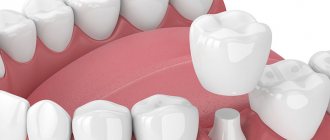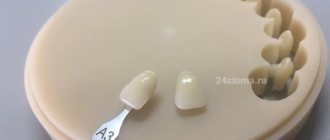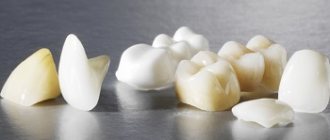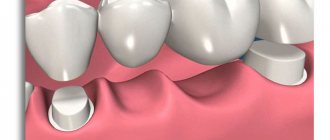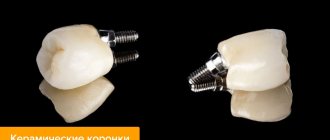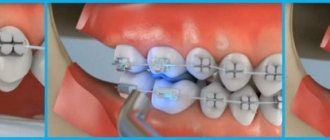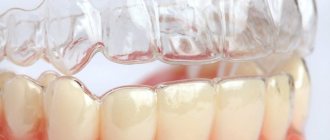Installing a temporary crown on an implant
Not all implantation methods involve installing a temporary crown on the implant. This is only possible when using a one-stage technique with instant loading. As a rule, the method is used to restore front teeth. The possibility of installing a temporary crown on an implant is also associated with the special structure of artificial roots used for one-stage implantation. Firstly, these implants are one-piece, that is, they are already connected to an abutment, onto which the prosthesis is then attached. And secondly, such structures are equipped with a special thread, so they seem to be screwed into the bone tissue without the need to drill out a place in it for the implant, as is done with the two-stage technique. In this regard, implants for a one-stage implantation procedure are attached more securely, and therefore are able to withstand the weight of a temporary crown and normal chewing load from the first days of installation.
Modeling and installation of temporary structures
Provisional crowns are made in two ways: direct and indirect. The first makes it possible to receive the finished product within an hour.
- The orthopedist takes a silicone impression.
- Grinds the tooth.
- Plastic is poured into the impression and placed on the prepared tooth.
- Then the impression is taken. The hardened plastic product remains in place.
- The orthopedist can only grind off the excess, grind and polish the new one.
The indirect method is used in laboratory conditions, using silicone, plaster and wax. This method gives more effective results. A temporary crown best matches the anatomy of the patient’s jaw; it is more reliable and durable.
Do I need a temporary crown for an implant?
Do I need to put temporary crowns on implants? If the operation is performed in the smile area, then it is advisable to do this. Natural pressure when chewing food will activate metabolic processes in bone tissue and stimulate their restoration. Moreover, the installed crown will help achieve a beautiful gum contour and also prevent the loss of soft tissue. As for the implantation of chewing teeth, according to most experts, it is better to carry out the operation in two stages with delayed installation of the crown.
Price list for orthopedic treatment
| Name of service | Price |
| Solid metal crown Crowns are made from cobalt-chrome, nickel-chrome and titanium alloys. They are durable and good for restoring the chewing function of teeth, but do not restore aesthetics. Find out which crowns are not only durable, but also aesthetic | 10000 ₽ |
| Metal-ceramic crown Crowns consist of a cast metal base and a ceramic layer applied to the metal. Metal-ceramic crowns combine the strength of metal and the aesthetics of ceramics. Learn about the pros and cons of metal-ceramic restorations | from 16500 ₽ |
| Metal-ceramic crown on an implant | from 42000 ₽ |
| Zirconium dioxide crown Ceramic-veneered zirconium dioxide crowns are both durable and beautiful. Modern materials and technologies for the production of dental crowns make it possible to abandon the choice between “Reliability” and “Beauty”. Find out what it means to choose a crown without compromise | 38500 ₽ |
| Veneer Installing veneers on your front teeth is a sure way to a flawless smile. Veneers remove the space between teeth, change the color of darkened teeth, correct the position and shape of teeth, and cover fillings and chips. If you only agree to impeccable aesthetics in the “smile zone,” choose ceramic veneers. | 27500 ₽ |
| Permanent fixation of the crown | 1000 ₽ |
| Taking an impression | 1600 ₽ |
| Temporary crown The Dental Association of Russia (STAR) recommends the use of temporary dentures as a cosmetic and functional guideline for the manufacture of permanent denture structures. What else do you need to know about temporary crowns? | 2100 — 6500 ₽ |
| Stump tab | 7000 — 8000 ₽ |
| Removable acrylic prosthesis IVOCAP | 45000 ₽ |
| Clasp prosthesis | from 48000 ₽ |
| Flexible removable denture Acry Free Whatever opportunities modern dental implantation provides, there are patients who, for various reasons, cannot take advantage of this prosthetic technology. The Acryfree® material developed by the Israeli company Perflex makes it possible to produce aesthetic removable dentures that are completely biocompatible and do not contain components that cause allergic reactions. | from 42000 ₽ |
Making temporary crowns for implants
Temporary crowns for dental implants are in most cases made of plastic. Please note that metal-ceramics, all-ceramics and zirconium are used to make permanent crowns for implants. If a doctor offers to make a temporary crown, for example, from metal ceramics, think about his honesty and competence. It may happen that the same structure will be installed twice: as a temporary and permanent one. Of course, for a double fee.
Shaping the gum contour using temporary crowns
With one-stage dental implantation, when a tooth is removed and an implant is immediately installed in its place, a temporary crown (if it can be installed immediately) allows you to preserve the natural contour of the gum around the tooth, preventing the gum from filling the tooth socket.
If it was not possible to immediately install a temporary crown on a dental implant, and the gums have leveled out during the healing of the implant, then temporary crowns help form the correct gingival contour. Let's take a closer look at how this happens.
After the implants have healed, gum formers are screwed into them, which allow access to the implant to be created (sometimes gum formers are installed at the time of dental implantation).
Result after removal of the gum former:
The crown in the lower part has the shape of a cone, so with a special drill or laser the hole from above is expanded to give it a cone-shaped shape, like natural teeth. The expansion is performed under local anesthesia. The advantage of using a laser is that the vessels are immediately sealed and this operation is practically bloodless.
Temporary crowns for implants are made by an orthopedic dentist on the day of the patient’s visit using wax models prepared in advance in the laboratory. A temporary abutment (crown base) is screwed into the implant, and temporary crowns are fixed onto the abutment using temporary cement.
While wearing temporary crowns (about 2 weeks), the gums heal and finally take the desired shape, not only around the crown, but also filling the interdental space (gingival papillae are formed).
Temporary crowns are easily removed, since the fixing composition is not strong (this was done specifically so that the temporary crown can be removed without damaging the implant). If the crown falls off ahead of time, then it must be fixed in place as quickly as possible so as not to disturb the healing of the gums.
Having removed the temporary crowns after 2 weeks, the doctor sees a well-formed bed:
Impressions can now be taken to make permanent crowns that will look perfect from all angles.
While the permanent crowns are being manufactured, temporary crowns are re-installed on the implants.
After the permanent abutments and crowns are made, the temporary structures are removed and the permanent crowns are fixed onto the implants. Thanks to the preparation of the gums, permanent crowns look absolutely natural from all sides.
Without preliminary preparation of the gums, black triangles remain between the teeth, and food gets clogged between the teeth.
Thus, temporary crowns are necessary to create tight contact between the gum and the crown on the implant, which ensures not only aesthetics, but also the health of the gums and the ease of use of the crowns.
How long does it take to make a temporary crown on an implant?
Direct method.
The doctor takes an impression using silicone mass, pours a plastic solution into it and puts it all on the implant. Once the resin has cured, the silicone impression is removed and the temporary crown remains on the implant. It is given the required shape, polished and ground, and then secured with special cement.
- Quickly produced.
- Similar to natural teeth.
- Porosity, due to which there is a risk of infection.
- Discoloration due to coloring products.
- Short service life.
- More fragile.
Indirect method.
Based on the casts, a plaster model of both jaws is created in the laboratory, which is used to make a wax crown. A temporary plastic crown is created using the wax model. Sometimes, in the manufacture of plastic crowns, a metal base is used to extend the service life of the products.
- More durable compared to crowns made using the direct method.
- The individual characteristics of the patient are taken into account.
- No.
Making temporary crowns for implants using the direct method in an orthopedist’s office will take no more than an hour. A dental laboratory will make a temporary crown made of plastic in a couple of days.
Types of plastic crowns –
The traditional option for making such crowns is acrylic plastic. But such plastic can be very different. The most common cheap option is acrylic monomer plastic (most often containing the monomer “methyl methacrylate”). Subsequently, excess monomer can be released from the crown, leading to the development of allergic reactions and inflammation of the gums around the crown. Crowns made from this material have low biocompatibility and wear resistance.
Crowns can also be made of special composite plastic (with the addition of composite) or acetate-free monomer plastic. These plastic options do not contain a toxic monomer, and therefore the risk of allergic reactions in this case is extremely low. But the best manufacturing option is plastic, which is hidden under the abbreviation “PMMA” (polymethyl methacrylate).
What are PMMA plastic crowns:
PMMA crowns are made by milling special plastic blanks (blocks, disks) on a computer-controlled machine. To do this, an impression is taken from the ground teeth, and a plaster model of the teeth made on its basis is digitized. Subsequently, based on the digital impression, the shape of your temporary crowns is modeled on a computer, and their digital profile is sent to a computer-controlled machine, which mills the crowns without human intervention.
Plastic crowns made of PMMA (in Russian transcription - PMMA) not only have maximum accuracy, i.e. they will fit as tightly as possible to the neck of the tooth, but also with the highest degree of biocompatibility. In addition, such crowns may have a higher level of aesthetics, but this will also depend on the PMMA manufacturer. The fact is that PMMA blocks from different manufacturers have different properties, for example, in terms of color - they can be single-layer or multi-layer (Multi-PMMA).
Crowns milled from “multi-layer” PMMA –
“Multi-layer” means that the PMMA resin block will have a gradient of color and transparency, which will allow the crowns themselves made of this material to have the same gradient. This will make even plastic crowns more like real teeth. Reviews of plastic crowns for teeth made of PMMA indicate that their service life can reach about 2 years, which is very long by the standards of temporary prosthetics using plastic. Below you can see how a PMMA disc is milled into a 3-unit bridge.
Milling plastic crowns made of PMMA (video) –
Later in the article we will also show you photos of plastic crowns made from different materials. And you can judge their aesthetics for yourself.
What to do if a temporary crown on an implant falls out or is swaying?
Sometimes temporary crowns on implants begin to wobble due to poor-quality fixation or poor implant abutment. However, there are cases when the patient cannot determine exactly what has become unstable - the temporary crown or the artificial root itself. Therefore, at the first signs of mobility of the temporary prosthesis on the implant, you should immediately contact the doctor who performed the implantation procedure. Only he will be able to correctly determine the condition of the artificial root and more securely attach a temporary crown to it.
Rules for wearing, care and adaptation
Temporary prosthetics are created very quickly and are not highly accurate, and naturally, the patient may feel some discomfort after its installation. Most often, such a prosthesis will interfere a little when closing the jaws. It is recommended that you tell your doctor about all the inconveniences, who will make adjustments and make it more comfortable and convenient.
Since temporary cement is used for fixation, the provisional prosthesis is not very securely fixed in the oral cavity. Therefore, to protect it (and the tooth itself), some precautions should be taken:
- avoid eating “stretchy” foods: toffees, chewing gum, etc.,
- reduce the chewing load on the temporary prosthesis: it is better to chew food on the opposite side,
- avoid eating solid foods
- Carry out hygiene procedures with caution: use threads especially carefully. An irrigator that gently and efficiently removes pieces of food from the interdental spaces will be a good help.
Why are temporary crowns placed before permanent ones?
It may seem that a temporary crown is an extra material cost and should not be included in the cost of prosthetics.
Let us dwell once again on the need to use temporary crowns and emphasize their main advantages.
- Psychological calm.
Imitating your own teeth allows you to maintain self-confidence without introducing an imbalance in your daily activities (during business negotiations, smiling, talking, etc.). - Safety of soft tissues of the oral cavity
(prevention of inflammation and atrophy). - Preserving the functionality of teeth.
Thanks to the complete chewing process, possible undesirable consequences for the digestive system are eliminated. - No problems with diction.
- Fast adaptation.
Getting used to the future permanent prosthesis is much easier if you wear temporary crowns first. - Economy.
A temporary crown is a quick “reanimation” of teeth at an affordable cost.
Advantages and disadvantages
The advantages of temporary crowns include the following:
- plasticity of the material: the “cap” can be easily modified directly in the patient’s mouth. It won't cause any discomfort.
- lightness of the design and speed of its manufacture: in just 1 hour you can “hide” a ground tooth or implant under a temporary prosthesis, which will not put strong pressure on the support and gums,
- low cost: many clinics include this price in the general price list,
- quite good aesthetics: of course, this directly depends on the material. Therefore, it is better to choose products made from composite, they look more natural and last longer,
- high-quality tooth protection from light loads,
- there is no need for special hygienic care,
- Possibility of installation with bracket systems and aligners.
Such prostheses also have disadvantages, and it is because of them that the wearing period is often reduced:
- plastic quickly darkens: under the influence of tea, coffee, etc. It is impossible to bleach it, because... the pigment penetrates deeply into the porous structure of the plastic. Therefore, plastic dentures quickly darken even with high-quality care,
- the original color of the plastic is very white: this is also a minus, since the “cap” makes other segments of the smile look unattractive,
- allergic reactions are possible: this applies to a greater extent to plastic and acrylic,
- the fixation on the support is not very tight (like permanent ones): which can lead to peeling off,
- You must adhere very strictly to dietary recommendations: you cannot eat hard foods, or very hot or cold foods. Dentists advise avoiding dark and brightly colored foods.
- short operating time.
How long can you walk with a temporary crown?
Temporary crowns are a quick restoration of the aesthetics and functionality of teeth until permanent dentures are installed. Their service life is the time required to create permanent orthopedic structures, as well as implant healing. When can a permanent prosthesis be installed on an implant? Up to 4 months is the healing period of the implant in the lower jaw, up to 6 months in the upper jaw. After this, permanent dental prosthetics can be performed.
In some cases, for example, after implantation of All-on-4, All-on-6, a temporary prosthesis can last up to two years. During this time, the patient will have time to financially prepare for the installation of a high-quality permanent prosthesis. If the patient uses a temporary crown for a long time, it is necessary to come to the clinic every six months for a preventive examination. When worn for a long time, the following complications may occur:
✔
abrasion of crowns, leading to displacement of adjacent teeth;
✔
inflammation of the gums due to the accumulation of bacteria on plastic;
✔
gum growth and pain due to damage to the crown.
To make a temporary crown on an implant last longer:
- avoid sticky and hard foods;
- brush your teeth gently, without pressing hard on the area where the implant is installed;
- floss as carefully as possible.
Crown materials
Temporary crowns can be made from a variety of materials depending on the patient's budget and desired result. The most commonly used materials are plastic and special composites. These materials are sufficiently durable and relatively inexpensive, which is great for short-term wear. Of course, if the patient wishes, the crown can also be ceramic, metal-ceramic, or made of durable zirconium dioxide.
A distinctive feature of plastic products is that they tend to change their original shade due to exposure to food coloring, smoking, etc. Also, plastic is not able to withstand strong pressure during chewing, as a result, chips, cracks may appear, and the crown may even fall out. Due to the porous surface, pathogenic microorganisms can penetrate into the product.
If for some reason plastic is not suitable for the patient or he is allergic to this material, then the doctor may recommend the use of a composite, for example, acrylic. Such crowns are made directly in the patient’s mouth by layer-by-layer application and fixation using a special lamp.
